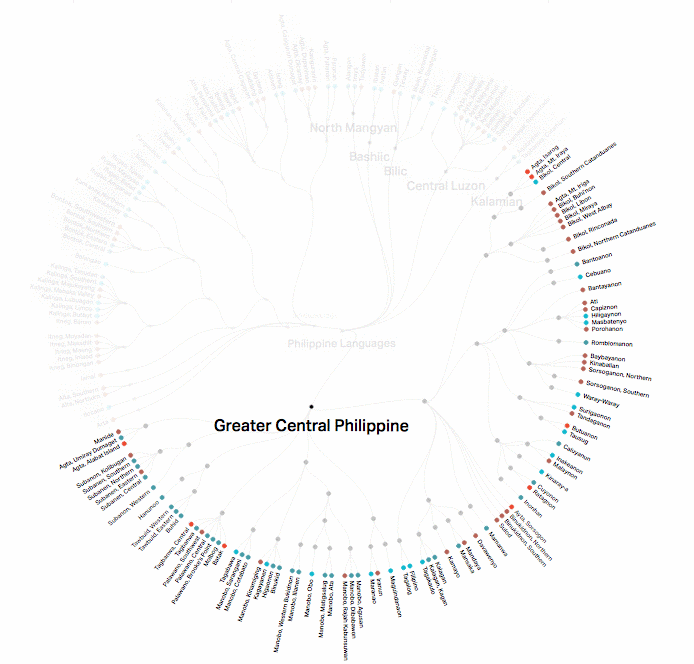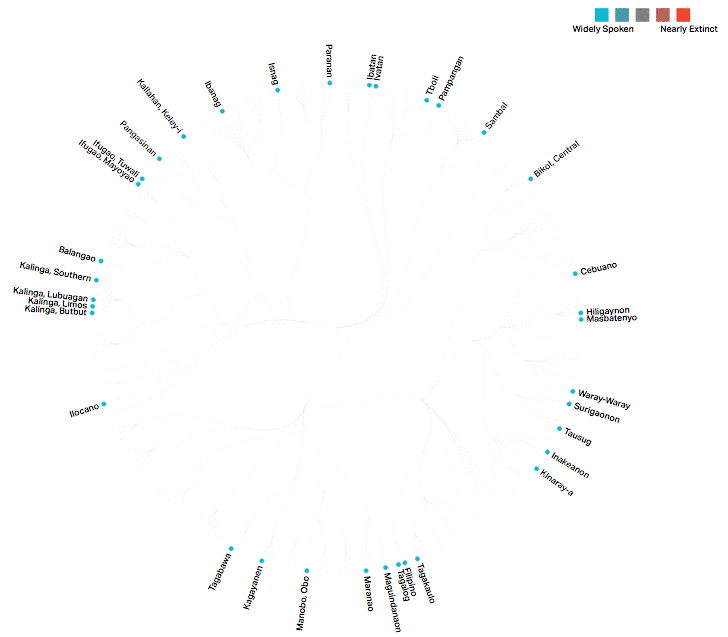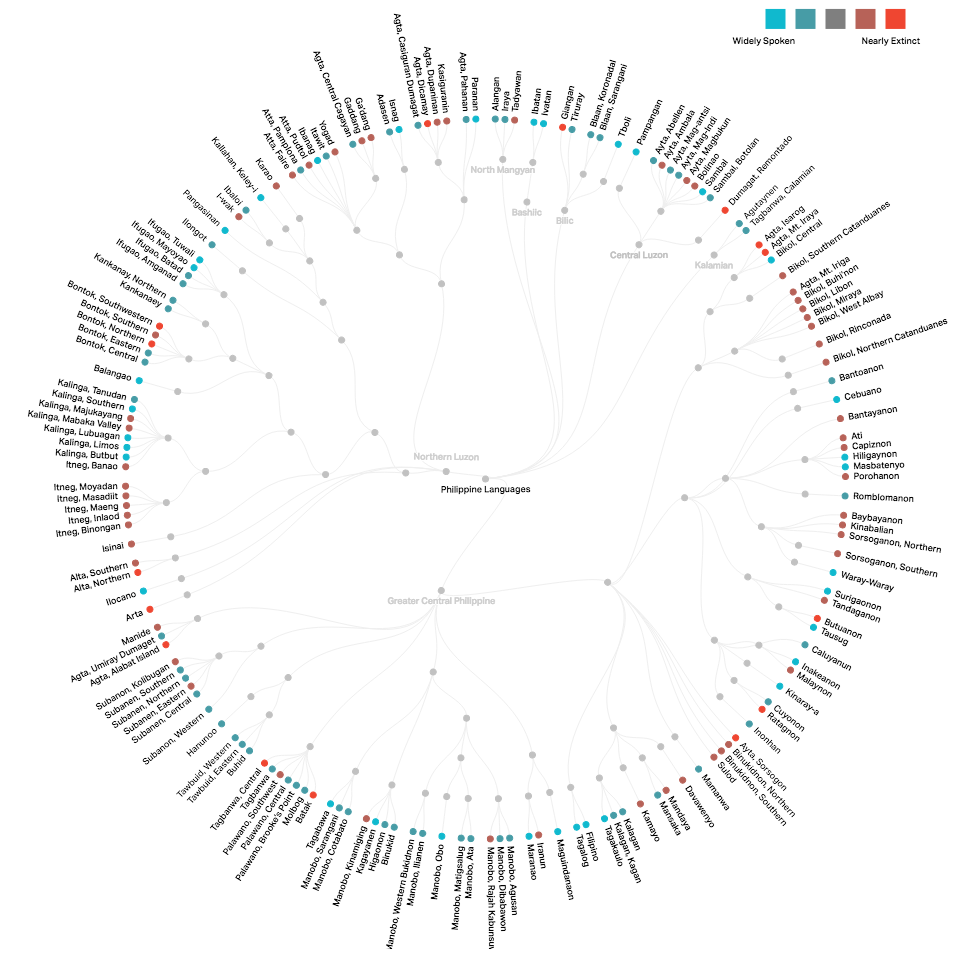Visualizing the Family Tree of Philippine Languages
August 30, 2016
In an earlier blog post, we wrote about the amazing diversity of languages in the Philippines. But how do these diverse languages relate to one another? For the second installment of our data visualizations for #BuwanNgMgaWika, we tried to visualize the family tree of Philippine languages as published on the website Ethnologue.
(Note: For simplicity, we removed from our visualization some language subgroups that Ethnologue said are related to Philippine languages but are mainly spoken in either Indonesia or Taiwan).
Broadly speaking, languages can be classified by how they’re structured, their word order, or the types of sounds they use. Most Philippine languages belong to the Austronesian family of languages, which is widespread throughout the Southeast Asia and the Pacific.
A major caveat: We are no experts in linguistics! So we can’t explain to you why the language tree is the way it is. Our purpose here was simply to re-visualize this information in way that someone interested in languages may find engaging. To learn more about Philippine languages, we suggest you check out more of Ethnologue, Glottolog, or this alternative, map-based visualization of the same dataset by Pinoy physicist Nathaniel Hermosa.
(Note: This article is best viewed on desktop.)
Ethnologue lists at least 187 languages and dialects spoken in the Philippines, divided into nine subgroups.

The largest subgroup is Greater Central Philippine subgroup, which includes languages spoken across a huge swath of the country, from Southern Luzon (Tagalog, Bikol), to the Visayas (Bisaya, Ilonggo, Waray), to Southern Mindanao (Maguindanao, Manobo, etc.).
The second largest subgroup is Northern Luzon, with its myriad of languages from across the Cordilleran region.
Altogether, there are nine subgroups of Philippine languages, the remaining subgroups being Bashiic, Bilic, Central Luzon, Kalamian, North Mangyan, Minahasan, and Sangiric languages. For simplicity, this visualization does not show the last two language subgroups, which consist of mainly Indonesian and Taiwanese languages closely related to Philippine languages.

Each language varies in level of use. Ethnologue measures a language’s vitality based on how widely used it is by both native speakers and institutions like government, schools, and media. These are the most developed Philippine languages.
On the other end of the spectrum, there are Philippine languages that are dying or already extinct. Dying languages are those that are no longer spoken by children, while extinct languages have fallen completely out of use.
The remaining Philippine languages lie somewhere in the middle of this spectrum. These include languages that still have native speakers but limited or unstandardized literature, or languages that are in danger of no longer being spoken by new generations.
Between 1960 and 2010, the percentage of Filipino households that use Tagalog has doubled, while other languages have remained steady or declined. In the Philippines and around the world, loss of language diversity is real.

“A language is not just a body of vocabulary or a set of grammatical rules. A language is a flash of the human spirit. It's a vehicle through which the soul of each particular culture comes into the material world” -- Wade Davis, National Geographic Explorer
Ethnologue lists at least 187 languages and dialects spoken in the Philippines, divided into seven subgroups. (Click to continue)
The largest subgroup is Greater Central Philippine subgroup, which includes languages spoken across a huge swath of the country, from Southern Luzon (Tagalog, Bikol), to the Visayas (Bisaya, Ilonggo, Waray), to Southern Mindanao (Maguindanao, Manobo, etc.).
The second largest subgroup is Northern Luzon, with its myriad of languages from across the Cordilleran region.
Altogether, there are nine subgroups of Philippine languages, the remaining subgroups being Bashiic, Bilic, Central Luzon, Kalamian, North Mangyan, Minahasan, and Sangiric languages. For simplicity, this visualization does not show the last two language subgroups, which consist of mainly Indonesian and Taiwanese languages closely related to Philippine languages.
Each language varies in level of use. Ethnologue measures a language’s vitality based on how widely used it is by both native speakers and institutions like government, schools, and media. These are the most developed Philippine languages.
On the other end of the spectrum, there are Philippine languages that are dying or already extinct. Dying languages are those that are no longer spoken by children, while extinct languages have fallen completely out of use.
The remaining Philippine languages lie somewhere in the middle of this spectrum. These include languages that still have native speakers but limited or unstandardized literature, or languages that are in danger of no longer being spoken by new generations.
“A language is not just a body of vocabulary or a set of grammatical rules. A language is a flash of the human spirit. It's a vehicle through which the soul of each particular culture comes into the material world”
-- Wade Davis, National Geographic Explorer
Click on any language to learn more about it.


